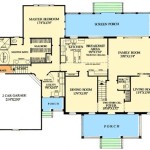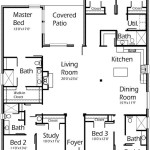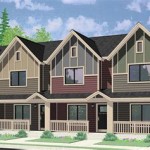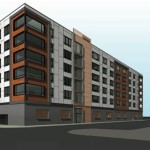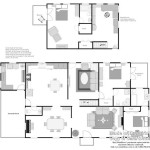Exploring Home Plans for 1000 Square Feet: Maximizing Space and Functionality
Designing a home, regardless of its size, requires careful consideration of spatial needs, lifestyle preferences, and budget constraints. When working within a 1000 square foot footprint, these considerations become even more crucial. A well-designed 1000 square foot home can feel spacious and comfortable, while a poorly designed one can feel cramped and inefficient. This article explores the key elements of effective home plans for 1000 square feet, providing insights into optimizing space and functionality for a variety of needs.
The allure of a smaller home is multifaceted. For some, it represents a commitment to a simpler, less materialistic lifestyle. For others, it's a practical solution to affordability, particularly in urban areas where land costs are high. Regardless of the motivation, homeowners are increasingly recognizing the benefits of downsizing and embracing the challenge of creating a comfortable and stylish living space within a smaller area. The success of a 1000 square foot home hinges on smart planning and thoughtful design choices.
Before diving into specific floor plans, it's essential to define the occupants' needs and priorities. How many bedrooms are required? Is a dedicated home office a necessity? Is a large kitchen a must-have for avid cooks? These questions will guide the design process and ensure that the final plan reflects the occupants' unique lifestyle. Compromises are often necessary in smaller homes, so understanding what features are non-negotiable is paramount.
Maximizing natural light is crucial in smaller homes. Ample natural light can make a space feel larger and more inviting. Incorporating large windows, skylights, and strategically placed mirrors can significantly enhance the brightness and perceived size of the interior. The orientation of the home on the lot should also be considered to optimize sun exposure throughout the day.
Key Considerations for 1000 Square Foot Home Plans
Several key factors are paramount when planning a 1000 square foot home. These considerations will inform design decisions and ultimately contribute to the overall livability of the space.
Open Floor Plans: Open floor plans are highly effective in 1000 square foot homes. By eliminating walls between living areas, such as the living room, dining room, and kitchen, a sense of spaciousness is created. This design approach allows for better flow and encourages interaction between occupants. However, it's important to define zones within the open space using furniture arrangements, area rugs, or changes in flooring to maintain a sense of order and functionality. Noise control can be a challenge in open floor plans, so consideration should be given to sound-absorbing materials and strategic placement of furniture to mitigate noise transmission.
Vertical Space Utilization: Exploiting vertical space is another crucial strategy. High ceilings can create a sense of grandeur and allow for the incorporation of tall cabinets, bookshelves, or even a loft space. Utilizing vertical storage solutions, such as floor-to-ceiling shelving or built-in cabinets, can maximize storage capacity without sacrificing floor space. Wall-mounted fixtures, such as floating shelves and wall-mounted televisions, can also free up valuable floor space and create a cleaner, more minimalist look.
Multifunctional Spaces: Designing rooms that can serve multiple purposes is essential. A guest bedroom can double as a home office, or a dining area can be transformed into a workspace when not in use. Furniture choices should reflect this versatility. For example, a sofa bed can provide sleeping accommodations for guests while serving as comfortable seating during the day. A dining table can also function as a desk, and storage ottomans can provide both seating and storage space. Thinking creatively about how each room can be utilized for different purposes is key to maximizing functionality in a small home.
Storage Solutions for Compact Living
Storage is invariably a primary concern in any small home design. Clever storage solutions are not merely desirable; they are essential. A well-organized home feels significantly larger than a cluttered one.
Built-in Storage: Built-in storage provides a seamless and efficient way to maximize space. Custom cabinets, bookshelves, and drawers can be integrated into the walls, eliminating wasted space and creating a clean, streamlined look. Under-stair storage is another often-overlooked area that can be transformed into valuable storage space. Built-in storage can be tailored to specific needs and design preferences, ensuring that every inch of space is utilized effectively.
Vertical Storage Solutions: As mentioned earlier, utilizing vertical space is crucial for storage. Tall cabinets, shelving units, and wall-mounted storage systems can significantly increase storage capacity without taking up valuable floor space. Consider utilizing the space above doorways for storage or installing shelving units that reach the ceiling. Vertical storage solutions can be both functional and aesthetically pleasing, adding visual interest to the room while maximizing storage capacity.
Hidden Storage: Incorporating hidden storage solutions can help to keep clutter at bay and maintain a clean, organized look. Storage beds with drawers underneath, coffee tables with hidden compartments, and benches with built-in storage are all excellent options. Utilizing these types of furniture pieces can provide valuable storage space without compromising the overall aesthetic of the room. Hidden storage solutions can be particularly useful in small spaces where every inch counts.
Floor Plan Options for 1000 Square Feet
Various floor plan options exist for 1000 square foot homes, each offering different configurations and layouts to suit diverse needs and preferences. The optimal choice depends on the number of occupants, lifestyle, and desired features.
One-Bedroom Layout: A one-bedroom layout typically features an open-concept living area, a separate bedroom, a bathroom, and a kitchen. This layout is ideal for singles or couples who prioritize open living space and a dedicated bedroom. The living area can be designed to incorporate a dining area and home office space. The bathroom can be accessed from both the bedroom and the living area for convenience. Ample closet space in the bedroom is crucial for maximizing storage. A well-designed one-bedroom layout can provide a comfortable and functional living space for individuals or couples.
Two-Bedroom Layout: A two-bedroom layout typically features a living area, a kitchen, a bathroom, and two separate bedrooms. This layout is suitable for small families, roommates, or individuals who desire a guest bedroom or home office. The size of the bedrooms will likely be smaller in a two-bedroom layout compared to a one-bedroom layout. Careful planning is required to ensure that each bedroom has adequate space for a bed, dresser, and closet. The living area is often more compact in a two-bedroom layout, so maximizing space is crucial. A two-bedroom layout can provide comfortable living space for families or individuals who need additional bedrooms.
Studio Apartment: A studio apartment is a single, open-concept living space that combines the living room, bedroom, and kitchen into one area. A separate bathroom is typically included. Studio apartments are ideal for single individuals who prioritize affordability and simplicity. Clever layout design is essential to create distinct zones for living, sleeping, and cooking within the open space. Multi-functional furniture is crucial in a studio apartment to maximize space and functionality. Studio apartments can be a cost-effective and convenient living option for individuals who are comfortable with open-concept living.
Material Selection and Finishes for Small Spaces
The choice of materials and finishes can significantly impact the perceived size and feel of a 1000 square foot home. Light colors, reflective surfaces, and minimalist design elements can create a sense of spaciousness and airiness.
Light and Neutral Colors: Light and neutral colors, such as white, beige, and light gray, reflect light and make a space feel larger. These colors create a clean and airy atmosphere, which is particularly beneficial in small homes. Avoid using dark colors, which can absorb light and make a space feel smaller and more enclosed. Lighter colors can be used on walls, ceilings, and floors to maximize the sense of spaciousness.
Reflective Surfaces: Incorporating reflective surfaces, such as mirrors, glass, and polished metal, can bounce light around the room and create the illusion of more space. Large mirrors can be strategically placed to reflect views and make a room feel twice as large. Glass doors and partitions can also help to create a sense of openness and allow light to flow freely between rooms. Polished metal fixtures and accessories can add a touch of glamour and reflect light, enhancing the overall brightness of the space.
Minimalist Design: A minimalist design approach is well-suited to small homes. Avoiding clutter and unnecessary ornamentation can create a sense of calm and order. Choose furniture pieces that are simple and functional, and avoid overcrowding the space with too many accessories. A minimalist design aesthetic can create a clean, uncluttered, and spacious feeling in a 1000 square foot home.

Our Top 1 000 Sq Ft House Plans Houseplans Blog Com

Three Low Budget 1000 Sq Ft Bedroom House Plans For 120 Yard 3 Cent Plots Small Hub

𝟏𝟎𝟎𝟎 𝐒𝐪 𝐅𝐭 𝐇𝐨𝐮𝐬𝐞 𝐃𝐞𝐬𝐢𝐠𝐧𝐬 With Images

Our Top 1 000 Sq Ft House Plans Houseplans Blog Com

1000 Square Feet Home Plans

House Plans Under 1000 Square Feet

1000 Sqft House Plan Customized Designs By Professionals Imagination Shaper

1000 Sq Ft House Plan N Design August 2024 Floor Plans

Traditional Plan 1 000 Square Feet 2 Bedrooms Bathrooms 348 00002

59 9 Imr House Plan Under 1000 Sq Foot 2 Bedroom Home Blueprints Concept Plans For

